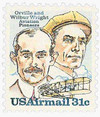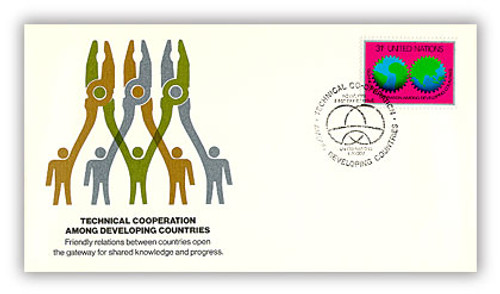
# C91 - 1978 31c Wright Brothers
1978 31¢ Wright Brothers and Plane
First City: Dayton, Ohio
Quantity Issued: unknown
Printed by: Bureau of Engraving and Printing
Printing Method: Lithographed, engraved (Giori)
Perforation: 11
Sons of a minister in the United Brethren Church, Wilbur Wright (1867-1912) and Orville Wright (1871-1948) grew up to become aviation pioneers. The brothers had always been interested in science and technology, but when their father gave them a flying toy in 1878, they set their sights on developing a heavier-than-air flying machine capable of carrying a man.
Beginning in 1899, the Wright brothers initially experimented with gliders. Within four years, they had built their first airplane. With a wingspan of 40 feet and a 152-pound, 12-horsepower engine, this plane was unlike anything seen before.
The first historic powered airplane flight took place in Kitty Hawk, North Carolina, on December 17, 1903. Orville flew for 12 seconds and traveled 120 feet. Later that day, Wilbur flew for 59 seconds and covered 852 feet.
By modern standards, the Flyer was not impressive. Its double-tiered wings and frame were made of balsa, plywood, and fabric, wired together for rigidity. A 12-horsepower petrol engine, strapped to the platform beneath the wings, catapulted the contraption down a wooden monorail to become airborne. The pilot lay beside the engine and held on. The craft was primitive and unstable. It had no seats, no wheels, and no flaps to control lateral movement. Nonetheless, an engine had powered it into the air.
Using a methodical scientific approach, the Wrights tackled these problems. Eventually they were able to improve stability and control, add seats and wheels, and most importantly, they could design more powerful engines. With each improvement, their aircraft set world speed, height, and distance records.
Despite the Wright brothers’ successful demonstration of powered flight, their innovation remained largely unknown for five years. In 1904 they made a total of 104 flights, but spent only about 45 minutes in the air. However, on October 5, 1905, their machine flew 24.2 miles, remaining airborne for 38 minutes and 3 seconds. The flight was only cut short by the airplane running out of fuel. In 1906, they received a patent for the first airplane.
When the Wrights approached the US military about their invention, they were met with skepticism. The brothers were relatively unheard of, and the military had just spent 50,000 dollars attempting to create a flying machine, only to fail. It was not until 1908 that the brothers received a contract from the military. The Wrights then performed a series of tests and demonstrations at Kitty Hawk, which received heavy coverage from newspapers. After those trials, Wilbur went to France and made many successful demonstrations of their invention. Soon, the entire world knew about their wondrous airplane.
1978 31¢ Wright Brothers and Plane
First City: Dayton, Ohio
Quantity Issued: unknown
Printed by: Bureau of Engraving and Printing
Printing Method: Lithographed, engraved (Giori)
Perforation: 11
Sons of a minister in the United Brethren Church, Wilbur Wright (1867-1912) and Orville Wright (1871-1948) grew up to become aviation pioneers. The brothers had always been interested in science and technology, but when their father gave them a flying toy in 1878, they set their sights on developing a heavier-than-air flying machine capable of carrying a man.
Beginning in 1899, the Wright brothers initially experimented with gliders. Within four years, they had built their first airplane. With a wingspan of 40 feet and a 152-pound, 12-horsepower engine, this plane was unlike anything seen before.
The first historic powered airplane flight took place in Kitty Hawk, North Carolina, on December 17, 1903. Orville flew for 12 seconds and traveled 120 feet. Later that day, Wilbur flew for 59 seconds and covered 852 feet.
By modern standards, the Flyer was not impressive. Its double-tiered wings and frame were made of balsa, plywood, and fabric, wired together for rigidity. A 12-horsepower petrol engine, strapped to the platform beneath the wings, catapulted the contraption down a wooden monorail to become airborne. The pilot lay beside the engine and held on. The craft was primitive and unstable. It had no seats, no wheels, and no flaps to control lateral movement. Nonetheless, an engine had powered it into the air.
Using a methodical scientific approach, the Wrights tackled these problems. Eventually they were able to improve stability and control, add seats and wheels, and most importantly, they could design more powerful engines. With each improvement, their aircraft set world speed, height, and distance records.
Despite the Wright brothers’ successful demonstration of powered flight, their innovation remained largely unknown for five years. In 1904 they made a total of 104 flights, but spent only about 45 minutes in the air. However, on October 5, 1905, their machine flew 24.2 miles, remaining airborne for 38 minutes and 3 seconds. The flight was only cut short by the airplane running out of fuel. In 1906, they received a patent for the first airplane.
When the Wrights approached the US military about their invention, they were met with skepticism. The brothers were relatively unheard of, and the military had just spent 50,000 dollars attempting to create a flying machine, only to fail. It was not until 1908 that the brothers received a contract from the military. The Wrights then performed a series of tests and demonstrations at Kitty Hawk, which received heavy coverage from newspapers. After those trials, Wilbur went to France and made many successful demonstrations of their invention. Soon, the entire world knew about their wondrous airplane.

















